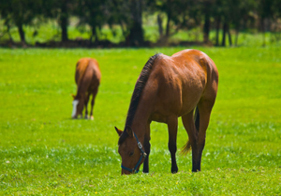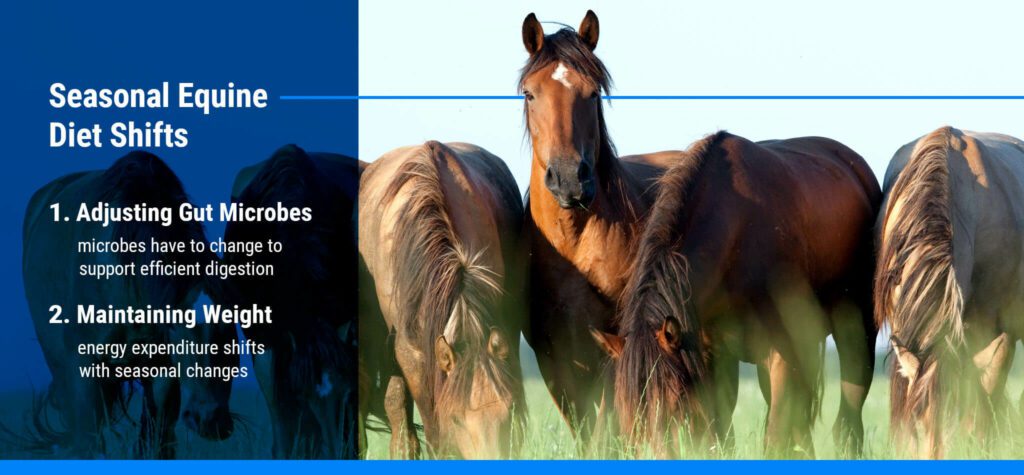Acclimating Horses to Grass

As a horse owner, the changing seasons bring additional considerations. Your pasture ebbs and flows during the seasons, and this creates natural variations in your horse’s diet. Managing these changes in a way that benefits both your horse and your pasture requires careful attention. Let’s take a look at some of the ways seasons impact how you feed your horse and tend to your land.
Table of Contents
- Seasonal Changes in Pasture Quality
- Impact of Seasonal Equine Diet Shifts
- Promoting Health Through the Seasons
Seasonal Changes in Pasture Quality
While your pasture fluctuates throughout all seasons, the most significant changes occur during drastic temperature shifts. This includes transitions from winter to spring and from summer to fall. Your pasture will also vary based on whether you’re growing a cool-season grass or a warm-season grass. The following are areas that may impact your pasture’s quality.
1. Cool-Season vs. Warm-Season Grass
Cool-season grasses grow best in temperatures from 60 to 75 degrees Fahrenheit. Common species of cool-season grass include:
- Annual and perennial ryegrass
- Creeping bentgrass
- Fine and tall fescue
- Kentucky bluegrass
- Orchardgrass
These grasses use fructans are their primary storage carbohydrate. They can also hold higher amounts of carbohydrates because they store their fructans in vacuoles rather than chloroplasts.
Warm-season grasses grow best in temperatures from 80 to 95 degrees Fahrenheit. This type includes species such as:
- Zoysiagrass
- St. Augustine grass
- Carpetgrass
- Bermudagrass
- Bahiagrass
These grasses utilize starch as their primary storage carbohydrate. In contrast to cool-season grasses, warm-season grass has a limited starch production and storage within its chloroplasts. Depending on what type of grass your pasture has, the nutrient content and growth will vary in spring and fall.
2. Spring Pasture Concerns
In the spring, cool-season grasses grow rapidly and produce a high amount of nonstructural carbohydrates (NSC). Though NSCs provide energy for your horse, high quantities may not promote optimal digestion and metabolic function.
In addition to NSCs, spring pastures have an influx of fructans. Neither humans nor horses have digestive enzymes to break down fructans. The microbes in your horse’s large intestine, however, can ferment fructans and trigger acid production. Monitoring the amount of NSCs and fructans your horse consumes in the spring is important to help maintain digestive and overall health.
3. Fall Pasture Concerns
During fall, your pasture may soak up sunshine and warmth during the day and experience cooler nights. In these conditions, pasture grass will manufacture sugars during the day and use them to grow overnight. As fall wears on and the evening temperatures become too cold for growth, plants store sugars for later use. This can create high concentrations of sugar in the grass.
While NSCs are less prevalent in the fall, fructans are still abundant. Considering the amount of fructans your horse consumes can help keep them healthy as they graze during this season.
Impact of Seasonal Equine Diet Shifts

Your pasture isn’t the only thing that changes with the seasons. Most horse’s diets switch from grass to hay when the weather gets colder. While the human body can switch from different foods without significant consequences, a horse’s digestive system is more fine-tuned. To sustain health during diet shifts, there are two main concerns for your horse:
- Adjusting gut microbes: The part of your horse’s digestive system that breaks down fiber is known as the cecum. The cecum houses a population of microbes that are tailored to your horse’s diet. When the diet changes, the microbes have to change in order to support efficient digestion. When alternating horses between hay and grass, it’s important to allow their gut microbes to adapt.
- Maintaining weight: No matter the season, a horse needs to consume a similar amount of calories as they burn to maintain a steady weight. During the winter, the cold temperatures require horses to expend more calories to stay warm. Keeping your horse’s nutritional needs in mind as the seasons change can help support their wellness while they adjust.
Promoting Health Through the Seasons
Regulating health throughout the year is important for both your horse and your pasture. Here are a few best practices for your animals and land when it comes to seasonal transitions.
How to Transition a Horse From Pasture to Hay
As the weather gets cooler and your horse spends more time in the stable, it will likely receive most of its nutrition from hay. The horse will need time to transition from all pasture grass to all hay. Fortunately, the fall to winter transition occurs more naturally than winter to spring. This is mostly due to the way grass declines into its dormant stage.
While horses may continue grazing during the fall, the grass supply changes. Growth declines, and the grass naturally loses moisture. This helps prepare your horse’s stomach for hay, which has a much lower moisture content than fresh grass. Allowing turnout during the fall and winter can help your horse transition gradually.
When your horse makes the switch to an exclusively hay diet, you can support their digestive health and nutrition with high-quality hay. The characteristics of high-quality hay include:
- Cleanliness
- A high stem-to-leaf ratio
- Stems that are small in diameter
- Minimal blooms and seed heads
- No musty smell or visible mold
- A bright color
In addition to high-quality hay, your horse needs fresh, clean water. Because hay is drier than grass, your horse will need to compensate with increased water consumption. Providing a salt block or sprinkling salt onto your horse’s feed may encourage them to drink more and stay hydrated throughout the winter.
How to Wean a Horse Back Onto Grass
It is crucial to know how to acclimate your horses to grass when spring rolls around. The way you handle the transition into spring is vital to your pasture’s health as well as your horse’s adjustment.
To keep your pasture healthy, allow the grass to grow at least six inches before letting your horse graze. You can expect this amount of growth to take approximately 21 days. Giving the grass this time to photosynthesize and gather energy prepares it for proper regrowth. When you allow your horse to begin grazing, it’s best to take a gradual approach.
Consider an incremental process like the following:
- Allow your horse to graze for 15 minutes for a few days.
- Increase your horse’s grazing time by 10 minutes each day until the horse can comfortably graze for 3 to 4 hours.
- Maintain a 4-hour grazing period for two weeks.
- Allow unlimited turnout and a full grass diet.
The livelihood of your horses and pastures matter. By taking a thoughtful approach to seasonal change, you can maintain your horse’s well-being and support smooth transitions year-round.
